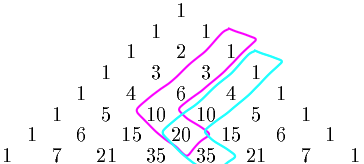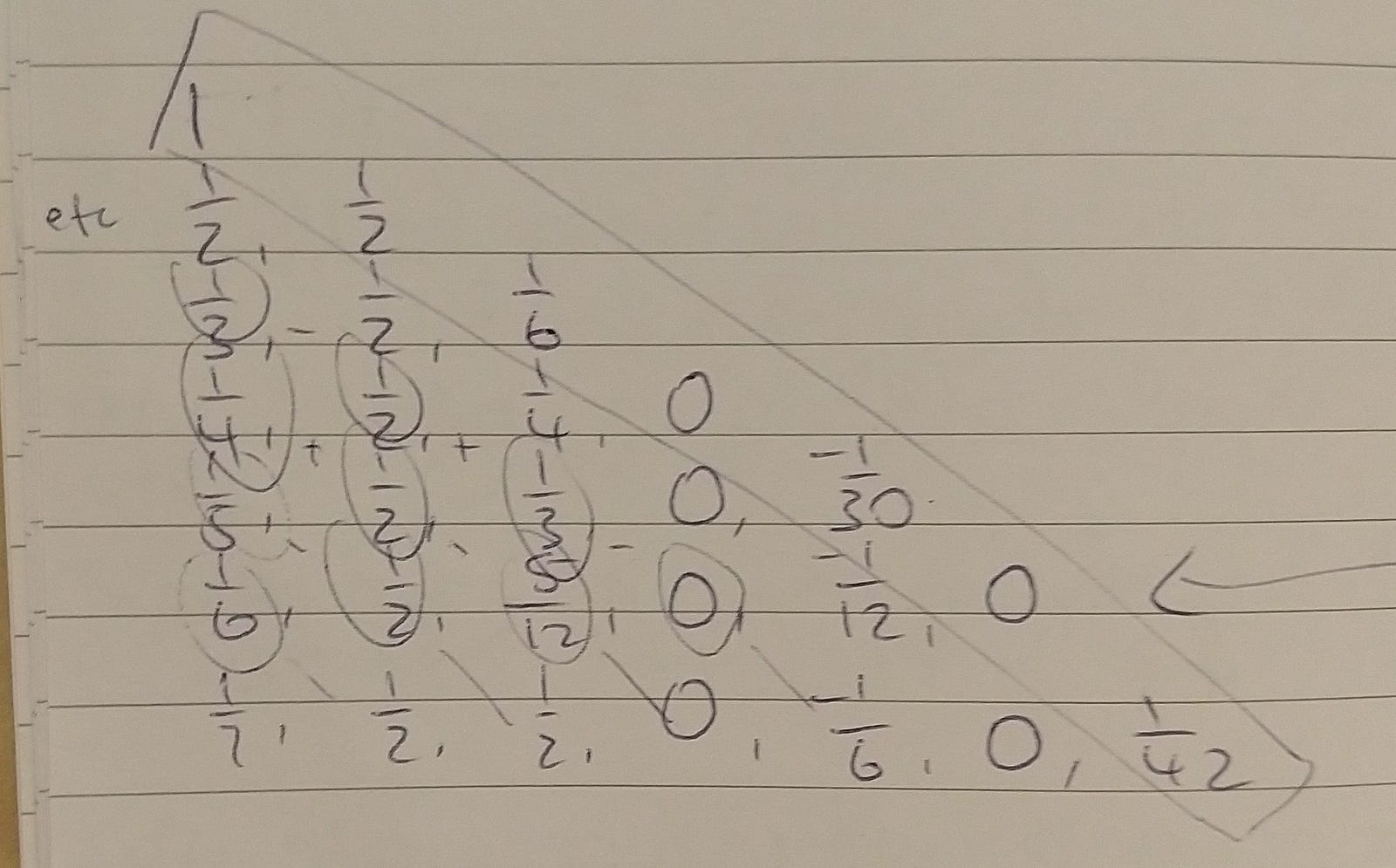Discovering Ada’s Bernoulli Numbers, Part 1
What the hell are Bernoulli numbers?
If you ask Wikipedia, it says it is this sequence of numbers:

What the hell. That’s the weirdest looking sequence of numbers I’ve ever seen. How can it jump to 0 and negative and positive and weirdo fractions. And why is it + or - 1/2 at the beginning?
Whenever I’m confused by something, I look up the history until it’s simple enough that I can comprehend it. Lo and behold, Jakob Bernoulli discovered these numbers when he was studying sums of powers.
Sums of powers? What are they? It’s these guys (where i goes from 1 to n):


The first line (of first powers) is the famous arithmetic progression, for which Gauss found the formula n(n+1)/2 when he was in primary school. There are formulas for all these sums:


But is there a formula for the general case, you ask? There are many —

It’s pretty complicated and requires a fair bit of algebraic manipulation. It’s recursive (it relies on knowing the formula for the powers below it). Bernoulli came up with a non-recursive formula, which is pretty much the one in use today. From the article by the MAA:
Bernoulli derived symbolic formulas for the sums of positive integer powers using the method conjectured by Fermat, then noted a pattern that would make computation of these formulas much simpler
The method conjectured by Fermat makes use of the fact that every number in Pascal’s triangle is the sum of numbers diagonally up from it (the Hockey Stick rule), eg. 20 is the sum of the pink numbers diagonally above it.


Numbers in Pascal’s triangles have a combinatorial formula eg. 20 = (6 choose 3) = 6*5*4/3*2*1. When we combine these two facts we get the following rule for the aqua numbers:

Which can be rearranged to get a formula for the sum of 2nd powers:

Fermat’s method is simpler than my one, and as Bernoulli said “Thus we can step by step reach higher and higher powers”.
But what are the Bernoulli numbers?
I had been studying sums of powers, so as an exercise I tried to discover the Bernoulli numbers myself. I held off reading the last post in the MAA series (which doesn’t say exactly how he discovered them anyway), and only allowed myself the hint that he found them whilst applying Fermat’s method for sums of powers.
I spent a long time manipulating Fermat’s formulas, and whilst I discovered Stirling numbers (and came up with a nice formula for them), I didn’t see any Bernoulli numbers. I almost gave up, but I didn’t. I decided to try generating the formulas for each of the powers to see if I could recognise a pattern. Instead of using Fermat’s method, which involves a fair bit of algebra, I used the method on brilliant.org which is similar to Pascal’s method:
Take the difference of binomial expressions in the power above the one you’re interested in getting the formula for:

Apply the summation operator to both sides:

The left-hand side collapses down to n³ and the sum of 1 n times is n so

That’s a simpler formula to expand given we know the sum(i) thing is n(n+1)/2. And it’s easy to keep going for higher powers.

And when I started expanding these out, I noticed a recursive pattern. Let’s do it for the sum of 4th powers, given we have worked out the formulas for the sums of powers below it


We get this complicated looking thing, but it has a nice recursive pattern


If k is the power we want a formula for, the coefficient of the first term with the highest power is always 1/k+1. Let’s look at the last example for k=4. The first term is 1/5*n⁵. The next highest term only appears once, in the first bracket, so it’s coefficient is (5 choose 2)*(its coefficient in the previous sum, which is 1/4). The third highest term appears twice, so it’s (5 choose 2)*1/3 minus (5 choose 2)*(1/3 — which is the coefficient it had in the previous-previous sum). And the last so on until you get to the last power, which is always n. I probably lost you with all this text, but basically this recursive definition of previous sums and alternating combinatoric numbers means I could generate a table of these coefficients mechanically which represents the formulas of sums of powers. I started with 1 and calculated each row from the previous rows: each number was the result of an alternating sum involving the numbers in the diagonal, starting with the one nearest to it. The first number is always 1/k+1. Eg in the fourth row, the second number is 1/4*(6*1/3) = 1/2. The third number is 1/4(6*1/2) minus 1/4*(4*1/2) = 1/4. And the last number is 1/4*(6*1/6) minus 1/4*(4*1/2) plus 1/4*(1*1) = 0.


The Bernoulli numbers!! Yaaaaaas. I was pretty excited. Turns out the Bernoulli numbers are the coefficients of the last terms in the sums of powers formulas (which are polynomials). So the last line stands for the coefficients of the polynomial which is the formula for the sum of 6th powers:

Now we have a totally mechanical way to generate these formulas. I noticed some interesting properties. For example, the alternating sum of each row equals zero.

At some point, as I was calculating out by hand the 6th or 7th row, I noticed something else peculiar — that the Bernoulli numbers were showing up in the complicated sums I was doing to generate the numbers of each row. That’s when I realised I could just use the Bernoulli numbers (or the numbers in the outermost diagonal) as a shortcut to generate each row. Here’s that method for generating the 7th row:
Calculate the first 7 Bernoulli numbers by doing this elaborate alternating sum involving the combinatorial numbers and the previous Bernoulli numbers and dividing by 7:

Take the 7th row of Pascal’s Triangle:

and multiply them together and divide by 7:

E prego…these are the coefficients of the terms that you can add to get the sums of 6th powers. The way to get each coefficient [ n k ] where n is the power of interest and k is the position of the term (starting from 0) is

and you can sum these to get the sums of powers formula. Here is that formula from the Wikipedia page:


where the B numbers are the 0th, 1st, 2nd etc Bernoulli numbers. My formula for the nth Bernoulli number (which isn’t on the Wikipedia page) is

The shortcut I found using the Bernoulli numbers for generating the coefficients was just a coincidence unless I could prove they were equivalent. So I proved it.
